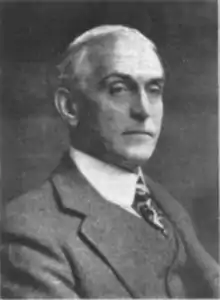Ripley Hitchcock
Ripley Hitchcock (born James Ripley Wellman Hitchcock; 1857–1918) was a prominent American editor. He edited the works of Rudyard Kipling, Arthur Conan Doyle, Zane Grey, Joel Chandler Harris, Stephen Crane and Theodore Dreiser.[1]
Ripley Hitchcock | |
|---|---|
 | |
| Born | James Ripley Wellman Hitchcock July 3, 1857 Fitchburg, Massachusetts |
| Died | May 5, 1918 (aged 60) New York, New York |
| Occupation | Editor, writer |
| Spouse(s) | Martha Barker Wolcott
(m. 1883; died 1903)Helen Sanborn Sargent
(m. 1914) |
| Children | 2 |
Biography
Ripley Hitchcock was born in Fitchburg, Massachusetts on July 3, 1857.[1][2] His father was surgeon Alfred Hitchcock (1813-1874). He graduated from Harvard University in 1877. After his graduation, he was a special student at Harvard in fine arts and philosophy. He attended lectures at the New York College of Physicians and Surgeons for one year.[3]
He started work as a journalist for The New York Tribune in 1882. In 1890, he became literary adviser for D. Appleton & Company, in which capacity he edited Edward Noyes Westcott's narrative David Harum (1898) into a bestseller, later made into a film. From 1902 to 1906, he worked for A. S. Barnes as vice president. From 1906 onwards, he worked as an editor for Harper and Brothers.[1] He unfanged Stephen Crane's lewd details and Theodore Dreiser's irony.[4]
He also wrote books on art and the history of the West and was a member of the National Institute of Arts and Letters, the Century Association and the Authors Club.[1]
He married Martha Barker Wolcott on May 23, 1883. She died in 1903, and he remarried to Helen Sanborn Sargent on January 7, 1914. They had two sons.[2]
Ripley Hitchcock died at the Park Avenue Hotel in Manhattan on May 5, 1918.[5]
Bibliography
| Wikisource has original works written by or about: Ripley Hitchcock |
- The Western Art Movement (New York, 1885)
- A Study of George Jenness, with a catalogue of the Jenness exhibition (1885)
- Etching in America (1886)
- Madonnas by old masters (1888)
- Some American painters in water colors: Fac-similes of new works by William D. Smedley ... [et al.] ; with portraits of the artists and representations of their work in black-and-white (1890)
- Thomas De Quincey: A study (1899)
- Louisiana Purchases Explorations Early History Building Of West (1903)
- Richard Henry Stoddard: Some personal notes (1903)
- The Lewis and Clark Expedition (1905)
References
- Wertheim, Stanley. A Stephen Crane Encyclopedia. Westport, CT: Greenwood Press. p. 155.
- The National Cyclopaedia of American Biography. XVIII. James T. White & Company. 1922. pp. 173–174. Retrieved December 28, 2020 – via Google Books.
- One or more of the preceding sentences incorporates text from a publication now in the public domain: Wilson, J. G.; Fiske, J., eds. (1892). . Appletons' Cyclopædia of American Biography. New York: D. Appleton.
- Lingeman, Richard . "The Biographical Significance of Jennie Gerhardt". Dreiser's Jennie Gerhardt: New Essays on the Restored Text. Ed. James L. W., III West. University of Pennsylvania Press: 1996, pages 11–13
- "Ripley Hitchcock Dead". Brooklyn Eagle. May 6, 1918. p. 14. Retrieved December 28, 2020 – via Newspapers.com.
